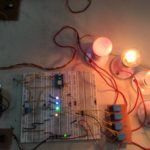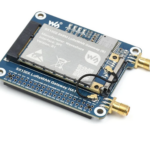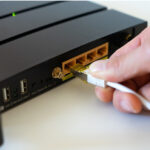As 5G is in full swing in the telecom segment, 4G modems are fast occupying the embedded space. The 4G GSM modems are useful in embedded systems for several reasons.
1. They provide a high-speed wireless connection to the internet. This allows embedded systems to access and process data in real time, which is essential for telematics, industrial automation, and remote monitoring applications.
2. The 4G GSM modems are relatively compact and lightweight, making them ideal for embedded systems that need to be small and portable. They’re also relatively low-cost, which makes them a viable option for a wide range of applications.
3. The 4G GSM modems are compatible with various cellular networks, worldwide. This makes them ideal for embedded systems that must communicate in different locations.
An affordable 4G modem is A7672S, a 4G LTE Cat 1 that supports wireless communication modes LTE-FDD/GSM/GPRS/EDGE, a maximum 10Mbps downlink rate, and 5Mbps uplink rate. This modem is also compatible with the SIM7000/SIM7070 series (NB/Cat M modules), and SIM800A/SIM800F(2G modules), which enables smooth migration from 2G/NB/Cat M products to LTE Cat 1 products.
The compact A7672S offers several interfaces, including UART, USB, I2C, and GPIO, as well as BLE and GNSS functions. This makes it suitable for a range of IoT applications, such as telematics, POS, surveillance devices, industrial routers, and remote diagnostics.
In this project, we’ll connect the A7672S modem to a computer and test some common AT commands available for the module. The modem is accessed through an evaluation board developed by Valetron Systems.
A closer look at the A7672S
The A7672S 4G modem is a wireless communication module that supports LTE-FDD/GSM/GPRS/EDGE modes. Currently, this is the most affordable 4G modem with all features available in India.
The modem variants available in different countries are:
- A7672S FASE and A7672S LASE in India
- A7672E FASE and A7672E LASE in Europe
- A7672SA FASE and A7672SA LASE in South and North America
Valetron Systems provides an evaluation board for A7672S, A7672E, and A7672SA modules made by SIMCOM. This 4G GSM module board works with Arduino, Raspberry Pi, and other popular development boards for evaluating the features of SIMCOM A7672 modules.
As the FASE variant supports GNSS and Bluetooth, the module is useful in various IoT applications. In addition to supporting the 4G-LTE-CAT1 network, it has a 2G fallback that switches it to a 2G network in rural areas without 4G. This module has support for analog audio compared to its predecessor 4G modules like SIM7600, which only had a PCM audio interface. Thanks to the provided bias circuit, it’s also possible to directly connect an electrets MIC to the board.
However, headphones or an amplifier are needed for the speaker output as the signal is weak and must be amplified.
The A7672S works with 9 to 42V DC input via its DC jack input. An extended operating range directly connects the modem to power sources like a lead-acid battery, DC adapters, or an EV supply.
The evaluation module has an onboard IO level translator for converting the modem’s 1.8V UART TX and RX lines to the MCU IO voltage level connected to the VTRANS pin.
The Valetron Systems evaluation board for the A7672S, A7672E, and A7672SA modules has the following pin diagram.
Connecting A7672S to a computer
Start by inserting a Nano size SIM card into the A7672S 4G module’s SIM slot. When doing so, ensure the board is powered OFF. The board can run on a 12V DC adaptor or a 3.7V to 4.2V battery. Depending on your choice, connect a 12V DC adaptor to the primary power input or connect a 3.7V~4.2V battery to the VBAT terminal.
Once the board is connected to a power source, the LED D18 will turn ON. Press the PWRKEY switch for at least one second to turn on the modem. The GSM_STATUS LED D17 will turn ON, indicating the module has been booted. Once the SIM is registered to the network, the NETLIGHT LED D6 will blink (otherwise, it remains stable).
A USB or UART interface can be used to communicate with a microcontroller or a computer.
A USB is ideal and convenient for connecting with a computer. The USB interface can send AT commands and update the module firmware. The module’s drivers must be installed on the computer beforehand.
The UART interface can be used only to send AT commands to the module. The baud rate by default is 115,200. The onboard TXS0104 or TXS0102 level translator converts the modules’ 1.8V UART TXD, RXD, DTR, and RI lines’ IO values to MCU IO levels because the modules’ IO levels are 1.8V. The VTRANS pin must be connected to either 3.3V or 5V of the MCU IO level voltage for the level translator to operate correctly.
Why connect to a computer?
Connecting the A7672S modem to a computer for testing AT commands is useful. It’s often necessary to verify the operation of various AT commands and derive a proper sequence of commands for desired tasks.
Testing the AT commands on a computer tests the module’s function and appropriate sequencing of the AT commands before coding them on a microcontroller.
Installing drivers
The drivers for the A7672S 4G modem must be installed on the computer before connecting the modem. To install the USB driver for a SIMCom modem on a computer, visit the SIMCom website or your modem’s product page to find and download the appropriate USB driver for your modem model.
Make sure you download the driver that corresponds to your operating system. The Windows drivers for the A7672S modem can be downloaded from this link.
After the driver file is downloaded, extract it to a location on your computer. This typically results in a folder containing the driver files. Connect the SIMCom modem to your computer using a USB cable. Ensure that the modem is powered ON and recognized by Windows.
You might see a notification that new hardware has been detected. Right-click the Windows start button and select “Device Manager” from the menu. This will open the Device Manager window. In the Device Manager window, find the SIMCom modem device. It might be listed under “Ports (COM & LPT)” or “Modems” — or in another category based on your modem type.
Right-click on the SIMCom modem device in Device Manager and choose “Update Driver.” Follow the on-screen instructions for installing the driver. When prompted, select the option to browse for the driver software on your computer. Then, browse to the location where you extracted the driver files.
Windows will search the specified location for the driver files. When it finds the appropriate driver, select it and click “Next.” Follow any additional prompts and instructions to complete the driver installation process. Once the driver is successfully installed, you should see the SIMCom modem listed without any warnings or errors in Device Manager. Now, the modem is ready for testing the AT commands.
Downloading SSCOM
To send AT commands to the modem from your computer, you’ll need the terminal application, which detects and connects to the modem. One such application is SSCOM. It can be downloaded from this link.
Download and install the SSCOM terminal on your computer.
Desktop setup
Insert the SIM card into the modem, connect the power adaptor, and press the PWRKEY switch for at least one second to boot the module. Once the module is ON and connected to the 4G network, connect the modem to your computer through a micro-USB data cable. Next, launch the SSCOM terminal.
As the modem is connected to the computer, it must be detected by the terminal application. Select the correct port under the PORT tab and start testing AT commands.
Basic AT command test
After the module is detected by the SSCOM terminal, it’s important to send the ‘AT’ command to ensure the modem is working properly. If so, send the ‘ATI’ command to display the product identification information.
- The manufacturer ID can be verified by sending the ‘AT+CGMI’ command.
- The model ID can be verified by sending the ‘AT+CGMM’ command.
- The overall features of the modem can be verified by sending the ‘AT+GCAP’ command.
Connecting and disconnecting a call
Next, test the modem’s calling functionality from your computer. In the terminal application, pass the command ‘ATD<mobile-number>;’ to initiate a voice call. To end the call, use the ‘ATH’ command.
You may also like:
Filed Under: Tutorials











Questions related to this article?
👉Ask and discuss on EDAboard.com and Electro-Tech-Online.com forums.
Tell Us What You Think!!
You must be logged in to post a comment.